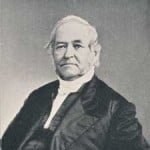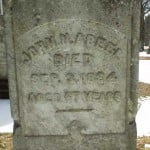Here’s to our Stated Clerks!
Back Creek Presbyterian Church, located in Mount Ulla, Rowan county, North Carolina, was organized in 1805, and is now a congregation of the Presbyterian Church in America. In the same year that the church was organized, church members George and Catherine (Barr) Andrews welcomed a child into their family, with the birth of Silas Milton Andrews on March 11, 1805. Young Silas later took his college education at the University of North Carolina, Chapel Hill, graduating in 1826. He worked as a teacher for several years before entering the Princeton Theological Seminary in 1828 and was regularly graduated in the Fall of 1831.
Mr. Andrews was licensed to preach by the New Brunswick Presbytery on February 2, 1831. Shortly after graduating from Princeton, he was ordained by the Presbytery of Philadelphia on November 16, 1831 and installed as pastor of the Presbyterian church in Doylestown, PA, with concurrent duties over a congregation still remaining at Deep Run, PA. The Doylestown church had originally begun in Deep Run, organized by the efforts of the Rev. William Tennent, and this church was first mentioned in the records of the Presbytery of Philadelphia in 1732. For forty-nine years Rev. Andrews labored in this one charge, without interruption, until the day of his death. The succession of pastors preceding him included William McHenry, Hugh Magill, James Latta, James C. Greer, Uriah DuBois and Charles Hyde.
One source tells us that Rev. Andrews was single-minded in his focus, “concentrating all his efforts on his charge, and taking very little part in outside affairs, gathering in from time to time large numbers of converts, and training and edifying his people in the way of truth, holiness and duty.” Perhaps to make ends meet during those early years when the congregation was smaller, Rev. Andrews also operated a private classical academy in addition to his pastoral duties. Rev. Andrews died on March 7, 1881.
This was a quiet and unassuming man, not one who sought attention for himself, not one given to pride or ostentation. He was a good scholar, fair and even-handed in his judgment, and he was a rather good preacher who knew the Scriptures well. From mid-October, 1848 until the reunion of the Old School and New School wings of the Presbyterian Church (PCUSA) in 1870, Rev. Andrews served as the Stated Clerk of the Synod of Philadelphia. He brought both care and attention to detail to his work, and had excellent penmanship as well.
Words to Live By:
Now here’s something you don’t think about often : We might from time to time be reminded to pray for our pastors, but when was the last time someone exhorted you to pray for our Stated Clerks? The record of the Church that they help to create is particularly crucial in future years, and each of them must exhibit that same character of meticulous care and accuracy if they are to do their work properly. Clearly this is not a work that just anyone can do, and do well. They are a rare breed.
For Further Study:
Apparently Rev. Andrews only wrote one work that was ever published, The Sabbath at Home, which was issued by the Presbyterian Board of Publication in 1836 and then reprinted twice, in 1837 and 1840. That book can be read online, here.
There was also a student’s journal which was preserved and later transcribed and published in 1958 as Mister Andrews’ School, 1837-1842. Transcribed and illustrated by Ellen Swartzlander and published in Doylestown, PA by the Bucks County Historical Society. The book is about 126 pages in length, and some 58 libraries around the country hold copies, so it should be easy to obtain via interlibrary loan.




